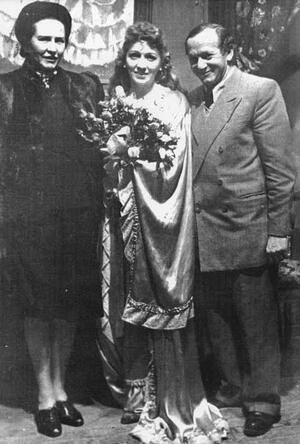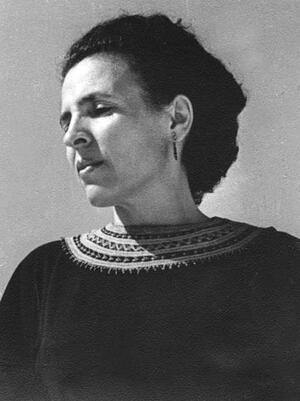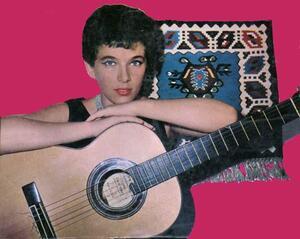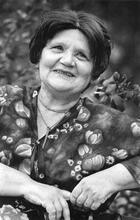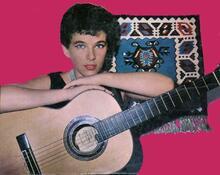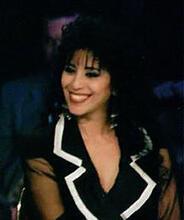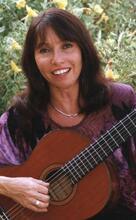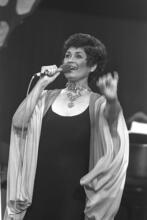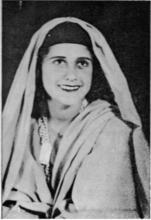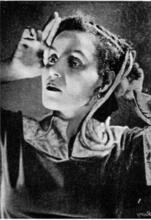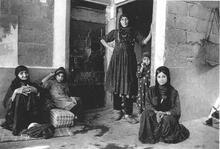Music: Palestine and Israel
Opera in Israel owes its creation primarily to singer, director and producer Edis De Philippe, who founded the Israel National Opera Company in 1947 and ran it with an iron hand for the next thirty-two years. She appears here with Hanna Rovina and the opera set designer Michael Gottlieb, after a performance of La Traviata (1945).
Institution: Shabtai Benaroyo.
The story of music in Israel is inextricably intertwined with the waves of immigration that broke upon its shores beginning in 1882. Each wave made its own unique cultural contribution. Each culture encountered both the others and that of the Old Yishuv, which they found on arrival. Music in Israel is thus a giant mosaic of cultures, styles, and musical traditions, which in one way or another integrated into the music made in the country prior to their arrival. Women played a significant role in all of these developments and often held central roles in the field of music in Israel.
Introduction
The story of music in Israel is inextricably intertwined with the waves of immigration that broke upon its shores from 1882 on. Each of these waves made its own unique cultural contribution. Each culture encountered the others, as well as that of the Old Jewish community in Palestine prior to the establishment of the State of Israel. "Old Yishuv" refers to the Jewish community prior to 1882; "New Yishuv" to that following 1882.Yishuv, which they found on arrival. Music in Israel is thus a giant mosaic of cultures, styles, and musical traditions which in one way or another integrated into the music made in the country prior to their arrival.
Until the fifth Lit. "ascent." A "calling up" to the Torah during its reading in the synagogue.aliyah (1929–1939), folk music had a place of honor. With tremendous effort, a few composers dedicated themselves to writing, fostering, and distributing folk music, which they conceived as a primary means of coping with and overcoming difficult living conditions.
With the influx of immigrants from Germany and central Europe between 1929 to 1939, particularly after Hitler’s rise to power in 1933, the promotion of art music began alongside that of folk music. The term “art music” is used for lack of a better term. Art music, which is played from written notation on a concert stage and whose composition and performance require professional training, is also called “classical music,” but the latter term correctly refers to music written during the classical period (1750–1800).
The Palestine (later Israel) Philharmonic Orchestra was founded in 1936, followed by the Radio Symphony Orchestra in 1938. In 1923 Mordechai Golinkin opened the first opera company. The first music academy was founded in Jerusalem in 1936 by Emil Hauser and Dr. Helena Kagan. Thus were laid the foundations of professional music, without which no art music could exist. The country’s proficiency in this regard became known throughout the world.
With the arrival of the large waves of immigration from the east, ethnic folklore began to attract attention, and interest arose in Middle Eastern music.
Women played a significant role in all of these developments and often held central roles in the field of music, as will be seen throughout this article
Folk Music
One of the ways by which we can recognize a nation and what distinguishes it from other nations is the music that sings within it. Created within the nation, it is passed down from parents to their children and from one family to another for many generations. Its words express the nation’s hopes and dreams, and because it has existed for so many years no one can remember its source or who wrote it, and we tend to say that its composers are anonymous.
Throughout the Lit. (Greek) "dispersion." The Jewish community, and its areas of residence, outside Erez Israel.Diaspora, Jews were familiar with such folk music. In Eastern Europe, folk songs written in Yiddish conveyed the hopes and dreams emanating from small towns and ghettos. In Spain before the Spanish Inquisition, Ladino songs, “romanceros,” melodically expressed the Jews’ longings. However, the Jewish nation returning to its ancient-modern homeland wished to return to what it had previously been and to distance itself from those years of exile. Thus, the people cut themselves off from the Yiddish language and spoke only Hebrew. New folk songs, written in Hebrew, spoke of the Israeli revival.
For some reason, Yemen was not thought of as a diaspora but as a source of Israeli culture. Musicologists such as Avraham Tzvi Idelson (1882–1938) and Robert Lachmann (1892–1939) saw the Yemenite community as one that had been preserved intact since Second Temple times and had not been contaminated by the local residents among whom they lived. Yemenite melodies were therefore extremely sought after. The high priestess of these songs was the Yemenite-born Brachah Zefira, who not only did the songs justice but also succeeded in recreating in an artistically convincing way the Yemenite melodies that she had heard in her parents’ home and grown up with. These melodies became a source of inspiration for many composers who immigrated to Israel from Europe and wanted to internalize the Yemenite idiom, considered to be the original local idiom, thus making their compositions resemble what was then regarded as originally Israeli.
Brachah Zefira was not the only Yemenite singing star in Palestine’s skies. Others performing in this genre were Esther Gamlielit, Na’ama Nardi (Brachah Zefira’s daughter, 1932–1989), Shoshana Damari, and in a later generation, Ofra Haza. While Damari and Haza did not sing only Yemenite songs, the Yemenite idiom was strongly associated with them and was especially popular with their audiences.
At the beginning of the 1930s and 1940s, women composed primarily children’s songs. Among them were Theresa Goitein, Rivka Gwili-Broido (b.1910), Leah Barrons, Sylvia Hauser, Tikva Hendel, Bracha Kopstein, Lea Levitas-Goldis (1899–?), and Yehudit Sela Weiner.
After the establishment of the State of Israel a folk-like type of song was heard and it took the country by storm. The creators of this new style of song seemed to have asked themselves: what do we have that is more original, more common to all of us and that better expresses our source than Biblical verse? Thus they used verses that described the land—“of milk and honey”—and the miracles that happened in it—“and Moses struck the rock and water issued forth”—as lyrics for their new melodies. Nira Hen (b. 1924) and Sara Levi-Tanai are among the outstanding composers of this genre. Levi-Tanai’s song “El Ginat Egoz” (To the Nut Grove) is one of the most beautiful melodies composed in this style. However, fate was not kind to this ancient Middle Eastern genre of folk song. After the Six Day War, it seemed that Israeli society had turned its back on it, and it disappeared from the popular stage.
The second half of the twentieth century saw the ascendancy of Naomi Shemer. The style of this composer, who wrote the lyrics to most of her songs, was unique and she can be regarded as Israel’s troubadour. No other composer-lyricist succeeded in reflecting so faithfully and precisely everything that Israeli society has gone through over the years. Her 1967 song “Jerusalem of Gold,” first performed shortly before the Six Day War, virtually became Israel’s national anthem. Naomi Shemer’s songs may be seen as a bridge from the passé folk song to Israeli rock and pop music, which captured a place of honor for itself.
Art Music
Composition
As mentioned above, art music was introduced to Israel by the establishment of the Palestine Philharmonic Orchestra and the Radio Symphony Orchestra as well as the music academies in Jerusalem and Tel Aviv. As in the rest of the world, there were very few women composers involved in art music. Nevertheless, two women stood out for their compositions in Israel during the 1950s and 1960s—Vardina Shlonsky (1905?–1990) and Yardena Alotin (1930–1994). A native of Russia, Shlonsky was trained in Berlin and Paris, wrote many compositions and won prizes. Alotin was born in Palestine and graduated from the academy in Tel Aviv. She became a teacher at the academy and was the first woman composer who was native to Israel.
In the last decades of the twentieth century a change occurred in the status of women composers in the world and in Israel. Among those in Israel are Mary Even-Or (1939–1989); Betty Olivero; Haya Arbel; Noa Blass (b. 1937); Noa Guy; Rahel Galinne (b. 1949); Smadar Handelsman; Tsippi Fleischer; Chaya Czernowin (b. 1957); Hagar Kadima, who chaired the Israel Women Composer’s Forum, an association of approximately forty active Israeli women composers; Shulamit Ran (b. 1949); and Joan Franks-Williams (b. 1930). There is also Ella Lazar who, in addition to being a composer, is a successful singer.
With the exception of Betty Oliviero and Shulamit Ran, who both lived outside Israel for a long time, and to a certain extent Tsippi Fleischer and Chaya Czernowin, none of these women composers managed to penetrate the glass ceiling and win their way into the mainstream.
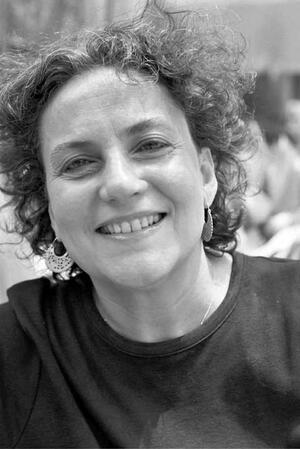
Institution: Betty Olivero
Performance
Israeli women have been more successful as musicians, singers and conductors than as composers.
Pnina Salzman is probably Israel’s first-ranking woman pianist. She returned from her studies in Paris during the late 1930s and became a premiere performer in Palestine. During World War II, she and Ella Goldstein appeared frequently with the Philharmonic Orchestra. Goldstein eventually left the country and was never heard from again, but Pnina Salzman continues to appear to great acclaim to this day. She is also a professor at the Tel Aviv Academy of Music.
Pianists Varda Nishry (d. 1995), Lola Granetman, and Yisraela Margalit stood out during the 1940s, along with members of the older generation, Ilona Vincze-Kraus (1902–1988), Edith Kraus (b. 1913), and Emma Gorochov. The latter three were also successful teachers. Also worthy of note are Israeli-trained Bracha Eden (1928–2006) (who formed an internationally-renowned duo with pianist Alexander Tamir), Ruth Menze, Milka Lacks (b. 1944), Ora Rotem-Nelken (b. 1993), and Idit Zvi.
The aliya from Russia during the 1970s and 1990s brought a large number of talented women pianists to the country, among them Dina Yoffe, Irena Berkovich, Gabriela Talroze (b. 1940) and the Israeli piano duo Nina Tjomkin (b. 1948) and Esther Abramson (b.1948). Of the young generation of women pianists, Michal Tal (b. 1962), Natasha Tadson (b. 1956), Revital Hachamoff (b. 1964), Orit Wolf (b. 1974), and Einav Yarden (b. 1978) are especially worthy of mention.
The number of violinists is fewer. In the 1920s Jenny Schmeltzer was the first woman violinist to perform in the country. At first considered a leading violinist, she faded from view when the symphony orchestra and the academy were founded. The most outstanding violinists are Miriam Fried (b. 1946), who was trained in Israel, moved to Canada, and visits Israel frequently, and Edna Michell (b.1939), who directs the Cantilena Ensemble. Also worthy of mention are Rimma Kaminkovski (b. 1949), Batsheva Savaldi-Kolberg, Vera Vaidman, and Yevgenia Pikovsky of the Israel Philharmonic Orchestra, who is also the leader of the Millennium Ensemble. The latter two immigrants from the former Soviet Union were trained in their country of origin.
There have also been some women cellists and violists of note. The leading Israeli women cellist was Thelma Yellin (1895–1959), an impressive personality and outstanding musician, who immigrated to Israel during the 1920s and founded several string quartets. Another cellist of the same period was Regina Schein. Rina Kohn was an excellent chamber musician who performed with the New Jerusalem String Quartet. Tamar Golan is an outstanding violist who now lives in London and performs throughout the world.
Israel has stood out in the quality of its chamber music and mainly in string quartets, the heart of chamber music. Although this quality declined in the last quarter of the twentieth century, it rose once more to even greater heights in the last five years of that century. At that time, three new and excellent string quartets were founded: the Huberman, Jerusalem, and Aviv Quartets. The last contains three excellent women musicians: Evgenia Epshtein, second violin, Shuli Waterman, viola, and Rachel Mercer, cello. More recently the Israel Contemporary Quartet has made a name for itself. As its name suggests this new quartet devotes itself to modern compositions and contains three women musicians: Hadas Fabrikant, first violin, Tali Goldberg, second violin, and Hilla Epstein, cello.
In the field of wind instruments, one must mention clarinetists Sharon Kam, Avigail Arnheim (b. 1957) and Orit Orbach (b. 1966), oboist Gabriele Bukowski, trumpeter Ariela Hibovsky and flautists Iris Gofer, Avigail Dolan, Ruth Ron, and Ronit Berman. Two more flautists, originally from the United States, deserve mention: Wendy Eisler-Kashi and Sharona Tel-Oren. The latter played with the Jerusalem Symphony for many years and also engaged in musical activity in the Negev. Flautist Drora Bruck (b. 1966) is known for her work in Baroque music and as a recorder musician. Another recorder musician is Yael Melzer-Shimshoni.
Harp has always been and still is a women’s instrument. Klari Sarvas, an outstanding Israeli harpist, was the first harpist in the Israel Philharmonic Orchestra. She was succeeded by Judith Liber, who is the artistic director of the International Harp Competition. Liber’s daughter Tali Glazer should also be mentioned here, along with Irena Kessler, Aviva Lustig-Wiesel, Adina Haroz, Edna Buchman, and younger harpists Julia Sverdlov (b. 1968) and Gitit Boazson.
In the vocal fields, soprano and alto are of course women’s areas. Although the absence of opera, which hardly existed in the country until the 1980s, hindered the natural development of Israeli women singers, there are nevertheless quite a few: Irena Zoltan, a star of the first opera, who came to The Land of IsraelErez Israel at the end of the 1930s; Edith Boroshek and Rose Pauly (1894–1975); Yosefa Schocken, who performed in recitals and with the opera; Hilda Zadek, who was the first Israeli-trained singer (at the Palestine Academy of Music in Jerusalem) to make an international reputation for herself in Europe; and Antonia Lavanne, who also graduated from the Academy and has taught for many years at the Manes School in New York. Netania Davrath (1931–1987) carved out a special place for herself, as did alto Mira Zakkai and soprano Gilah Yaron (b. 1941). All these were the foremost lieder and oratorio singers in Israel in the 1960s and 1970s. Adi Etzion-Zak, who also specialized in lieder, later created her own style: half cabaret, half operatic—combining song with acting and speech. The American born Robin Weisel Capsuta made a name for herself, both in opera and on the concert stage. In the last quarter of the twentieth century, soprano Michal Shamir (b.1956), who performed a great deal on German opera stages, stood out. Other outstanding singers are Tamar Rachum, Cilla Grossmeyer, Bibiana Goldental, Lili Tuna, Sivan Rotem, Sylvia Greenberg, Larissa Tatoyev, Liat Cohen, Avital Raz, and altos Bracha Kol (b. 1970) and Ella Sheriff (b. 1954).
With the development of the New Israeli Opera, the company has acquired some impressive voices. Although there are numerous guest singers from abroad, the reputation of Israeli singers, such as Sharon Rostof-Zamir, Meirav Barnea, and Edna Prochnik, is in the ascent.
It is also important to mention women performers of Yiddish song, although this may be more similar to folk music than art music. In Palestine there were two wonderful singers: Emma Schaver (1905–2003), who immigrated from the United States to Israel at the end of World War II, after traveling to the concentration camps; and Nehama Lifschitz, who came to the country with the renewed Lit. "ascent." A "calling up" to the Torah during its reading in the synagogue.aliyah from the Soviet Union in the 1970s.
Finally, conducting. To date, no woman has achieved outstanding professional recognition as an orchestra conductor anywhere in the world. The situation is no different in Israel, which can boast of only one woman conductor, Dalia Atlas (b. 1933). Even she never attained a major position and must content herself with the semi-professional Technion Orchestra in Haifa and a very few guest appearances.
However, women have achieved a great deal in the field of choir conducting, especially of women’s and girls’ choirs. Maya Shavit (b. 1935), founder of the Efroni Choir, deserves first mention. Other noteworthy conductors are Dafna Ben-Yohanan (b. 1960), conductor of the Ankor Choir, which has achieved a worldwide reputation; Anat Morahg (b. 1952) of the Bat Kol choir; Naomi Faran (b. 1952), who conducts the Moran Choir; and Ronit Shapira (b. 1950) of the Liron Choir. There are four additional women conductors who lead older children’s choirs: Rahel Kochavi-Leventer (b. 1941); Pnina Inbar (b. 1946); Malka Sverdlov, who worked successfully with the New Opera choir; and Sara Shoham, who is also a composer.
Ethnic Folklore
Just before the state was founded, and with the proliferation of communities that arrived on Israel’s shores, there came about an awareness of the need to recognize and preserve the ethnic folklore of each community. In line with the awakening of worldwide interest in the musicological world, this even received its own designation, ethnomusicology. While most musicologists in Israel were involved in this field in one way or another, the musicologist who did the most to raise such awareness was Dr. Edith Gerson-Kiwi, who was appointed a professor at the Hebrew University in Jerusalem. The uniqueness of this music is that it was transmitted from generation to generation and heard at family celebrations and in the synagogue. Its preservation in all its purity was of supreme importance. Key figures in this process were not composers, but “informants” who were asked to record their songs. This phenomenon is important for understanding future developments in non-art music in Israel.
Israeli Jazz
In contrast to ethnic folklore, which was indisputably original, jazz was a complete import. Nevertheless, it has attained a respectable niche in Israel, where there are festivals of jazz and its derivatives. Israeli women jazz musicians include pianist Liz Magnes (b. 1943) (now in the U.S.); percussionist and singer Iris Portugali and singers Edna Goren (b.1945), Revital Yemini, and Ricki Manor (b. 1950). There is also an ensemble that combines jazz with ethnic music, “Eve’s Women,” which includes drums, saxophone, contrabass and vocals.
Israeli Pop
Appropriately, given its name, pop music has achieved much popularity in Israel and attracts a large audience. The women songwriters and performers who have contributed a great deal to its success include Naomi Shemer, Nehama Hendel and Shuly Nathan, who rose to fame following the performance of Naomi Shemer’s song “Jerusalem of Gold.” Like Chava Alberstein, they accompanied themselves on guitar and appeared mostly in clubs and community-singing evenings. Chava Alberstein now writes her own songs and has won an international reputation.
Among the singers from the 1950s and 1960s is Rika Zarai (b. 1936), most of whose songs were composed by her husband, Yohanan Zarai, and were mainly cabaret ballads. She now lives in France. Esther Ofarim (Rechstadt) (b. 1943) who, together with her husband, constituted the Ofarim Duo, went on to make her own career and now lives in Germany.
There is a distinction between those singers who write their own material, such as Yehudit Ravitz and Si Heiman (b. 1961), and those who sing songs written by others, such as Rita (b. 1962), Nurit Galron, Gali Atari (b. 1956), Ahinoam Nini (Noa) (b. 1969), and Josie Katz (b. 1940) who are, above all, pop, rock and blues singers. It is also appropriate to mention a group of women singers who are bringing Oriental and Mediterranean pop to the public’s attention in a most impressive way. Etti Ankri (b. 1963), Sarit Hadad (b. 1978), and Zehava Ben (b. 1968) belong to this group.
There are four other women in this field, each different from the others: Nurit Hirsch, a composer and arranger who composes movie soundtracks and wrote the music to many of the lyrics of Ehud Manor; Alona Tourel (b. 1954), a pianist, accompanist and producer; Ora Sittner (b. 1946), a singer who accompanies her folk-popular songs on the piano; and Sara’le Sharon, who leads community singing from the piano and has a large following. Although the creation of folk music has vanished without a trace, Israeli society enjoys remembering it, especially in community singing evenings, which are common in Israel, arousing nostalgia and uniting the singers in companionship and solidarity.
World Music
In the 1990s, a new concept—“world music”—appeared in ethnic music. This refers to a combination of different ethnic styles—for example, ethnic Jewish-Arab music—into a unified musical expression. This is the complete opposite of the recognized tendency of fifty years earlier, the goal of which was to preserve pure ethnic expression. World music bows to multi-culturalism and seems to adopt pluralism as a guiding principle. Since its appearance in Israel, some ten vocal-instrumental ensembles have formed which play it. Of the women who participate in these ensembles, two soloists deserve mention: Ilana Eliya, a Kurdish singer who appears with a complex ensemble of stringed instruments and percussion; and Esti Kenan-Ofri (b. 1954), who is accompanied by the Zohar band, comprised of percussion and string instruments, and uses movement in her performances to enhance her singing.
Musicology
During the twentieth century there was a return to the area of research and science of music, forming the concept of musicology, which is researched and taught in institutions of higher education throughout the world. The main goal of musicologists is to discover, document and investigate different areas within the world of music that previously were not known or adequately investigated.
Musicology began in Palestine at the beginning of the twentieth century when Avraham Tzvi Idelson, a Jewish music researcher, came to the country in 1907. Until mid-century, there was very little activity in the field, but in 1967 the Israel Musicology Society was formed and the universities opened musicology departments one after the other. Today, such departments exist at the Hebrew University of Jerusalem, Tel Aviv University, Haifa University and Bar-Ilan University in Ramat Gan. The association has grown from the nucleus of its six founders to more than a hundred members.
Of these, we will mention the following women: Professor Edith Gerson-Kiwi, who, following in Robert Lachmann’s footsteps, developed the field of ethnomusicology of Israeli communities, while placing an emphasis on the Oriental communities; Professor Ruth Katz, who dedicated her research to opera and musical aesthetics; Professor Dalia Cohen, who deals with acoustics and Arab music; Dr. Bathja Bayer (1928–1995), who concentrated on Israeli folksongs and music during the Biblical period; and Dr. Ruth Cohen. These women worked or still work at the Hebrew University of Jerusalem. Likewise, we will mention Professor Yehudit Cohen, who focuses on late Renaissance and early baroque music, and Dr. Dorit Tanai, who concentrates on medieval music—both of Tel Aviv University.
The musicology faculty at Bar-Ilan University was established by Professor Batia Churgin, whose main area of research is the early classical period. The Israeli musicologist Talia Packer-Berio works in music publishing, mainly that of Schubert. Dr. Ronit Seter is active in the United States; her area is research in Israeli music, especially music written by women.
Music Education
In Israel, education is generally in the hands of women and a number of women are successfully involved in the field of musical education. They include Shulamit Ruppin (1878–1912) who founded the first conservatory in Palestine, in Yafo, in 1910 (moved to Tel Aviv in 1913), and then founded a second conservatory in Jerusalem. At about the same time Dunya Weizmann founded a conservatory in Haifa. Theresa Goitein, a rhythmics teacher in Jerusalem, set children’s poetry to music and children performed her works in rhythmic-musical shows. Hadassah Sherman (1910–1992), a music teacher at the Herzlia Hebrew Gymnasia, excelled in inculcating a love and understanding of music in her pupils.
By the 1940s rhythmics had an honored place in music education. Käthe Jacob, who, together with Leo Kestenberg and Emmanuel Amiran, founded the seminary for music educators in 1945, brought the Delacroz system to the country. Her student, Toni Steinitz, taught and spread this system of instruction, as did Yael Buckspan, who translated Käthe Jacob’s book and continued teaching the system.
At the end of the 1930s Dr. Helena Kagan, who was not a musician herself, founded the conservatory and Palestine Academy of Music in Jerusalem with Emil Hauser as musical director. Ten years later the teachers rebelled against Kagan and Hauser and started a conservatory and academy of their own. The leader of the rebels was Yocheved Dostrovsky-Kupernik, who ran the academy in Jerusalem for nearly thirty years. When she retired in 1979, Michal Smoira-Cohn was appointed to head the academy.
The Thelma Yellin School for the Arts, founded in 1961 by the head of the Tel Aviv Musical Academy, Oedoen Partos (1907–1977), was the first to offer music as an elective major for the matriculation tests. Miri Zamir-Capsouto (b. 1947) has headed the institution since the beginning of the 1980s.
Most of the well-known conservatories in the country are run by women. Prominent among them is Esther Narkiss, who directed the conservatory of the Jerusalem Academy from 1979 until 1996 . Her predecessors were Bracha Eden, who directed the conservatory for several years; Daniella Rabinovich, who ran the municipal conservatory in Tel Aviv; Ofra Broshi, who directed the Ran Shulamit Conservatory in Jerusalem; and Varda Hazan, who directed its Jerusalem branch in Beit Ha-Kerem; Amalia Reuel, who founded the Jerusalem Music Workshop with Liz Magnes and ran it for more than twenty years; her deputy, Aliza Levine; and Ruth Hilman, who founded the Rubin Conservatory in Beersheba in the 1960s and directed it for many years. Today, its director is Adele Deitchman.
Dr. Veronika Cohen (b. 1944), who is dean of the faculty for training music teachers at the Jerusalem Academy of Music and Dance, is one of the most significant policy planners in national music education. A central committee supervises music education in schools and among the regional supervisors who work with it is Bat-Sheva Rossenwasser (b. 1949), who served as the right hand of the national supervisor. Noga Fuchs supervises musical education in Jerusalem. Shoshana Weich-Shahak (b. 1938), who supervises music education in the center of the country, researches Judeo-Spanish music and Ladino songs. In 2001 Dr. Yael Shai was appointed as the chief supervisor of music education at the Ministry of Education.
Recently, several symphony orchestras have developed educational programs to assure themselves a future audience and work within the communities in which they make music. Two women active in this field are the pianist Irit Rub-Levi (b. 1957), who works with educational programs of the Israel Philharmonic Orchestra, and Michal Toussia-Cohen, who works for the Israel Symphony Orchestra in Rishon le-Zion.
Policymakers and Managers in Music
Those who direct the institutions that create and make music are, in effect, its policymakers. More precisely, every one of them creates some piece of the policy. Surprisingly, even though women’s independence in this country has yet to be realized fully in music as well as in most other areas, it appears that a significant number of policymakers in music are women.
Opera companies were formed in Israel three times. Mordechai Golinkin made the first attempt by putting on La Traviata on July 28, 1923. Edis de Philippe, a singer who came from America, tried again and managed and directed the Israel National Opera from 1947 until her death in 1979. In 1982 the opera closed because of lack of funding. The third attempt is the New Israeli Opera, under the patronage of the cultural department of the Ministry of Education and Culture. Today run skillfully and successfully by Hanna Munitz (b. 1946), many members of its staff are women. Founded in 1985, the new opera company has already won a worldwide reputation. It wisely combines standard repertoire with new Israeli operas.
When the conductor Michael Taube founded the Ramat Gan Chamber Orchestra in the 1950s, Shulamit Rosenberg was entrusted with its administrative management and continued in that position for many years after Taube’s death. The Israel Chamber Orchestra, founded by Gary Bertini, for many years was managed by Ruth Shahar. From 1995 to 2000 Idit Zvi was the administrative director. She also founded and managed the Chamber Music Festival of the Upper Galilee in Kefar Blum through the Israel Broadcasting Authority’s Voice of Music station.
In her position as the head of the music at the Israel Music Broadcasting Authority, Michal Smoira-Cohn was also placed in charge of the Jerusalem Symphony Orchestra. Previously, she served for a few years as the director of the Haifa Orchestra. Orit Fogel manages the Ra’anana Symphonietta. Ilana Barnea was in charge of musical programs and the local orchestra in Kefar Sava.
Conductor Dalia Atlas serves as the artistic and general manager of the Technion Orchestra in Haifa and of the Atlas Camerata, both of which she founded. Ada Peleg founded and manages the chamber music series at Beit Rothschild in Haifa, from which an international festival developed and whose orchestra she conducts. Also worthy of mention are clarinetist Avigail Arenheim, who is in charge of musical programs and concerts at the Tel Aviv Museum, and Esther Herlitz, who is not a musician but the adept director of the International Harp Competition and the Zimriyah, which brings together Jewish choirs from all over the world.
The state, via the Ministry of Culture, determines national policy toward music and is responsible for its well-being, which it ensures mostly through budget allocations to organizations, institutions and individuals. Raaya Zimran (b. 1949), the head of the music department in the ministry, works with the help of a committee composed of approximately thirty musicians and public figures in different areas of music. Michal Smoira-Cohn occupied this position during the 1970s and the second half of the 1990s until 2003.
Recha Freier deserves special mention, not as musician but as a leader, author and thinker who founded the Testimonium, which was initiated to serve as a musical codex for the Jewish people. After consultations with writers, she decided upon the main texts, commissioned musical settings for each of them from the best composers in the world, and then had them performed
Music in the Media
In 1982, the Broadcasting Authority established the Voice of Music radio station, which Michal Smoira-Cohn directed until 1991. Musical editors who were specialists in their respective fields worked with her, as a result of which the station brought about greater levels of music listening. Among these editors was Joan Franks Williams, who in the 1970s organized the first concerts of new music. Since her retirement, Zmira Lutzki has worked as chief editor for programs of Israeli music and modern music from all over the world. Together with composer Dan Youhas she also organizes orchestral and chamber concerts under the title “Meet the Twenty-First Century,” all of which are broadcast.
Ada Brodski (b. 1924) is a musician, author and translator who successfully developed historical programs in speech and sound, using musical drama in radio broadcasts. Hayuta Devir (b. 1946) is responsible for programs of soloists and chamber music, as well as the weekly Etnahta concerts that are broadcast live from the Jerusalem Theater. Idit Zvi was a musical program editor on Army Radio and later on the Voice of Music. Other women editors of music programs are Ricka Bar-Sela (b. 1945) and Tsippi Witzthum (b. 1946), who focus on music from the Baroque and Renaissance periods; Edna Anati (b. 1932), who produces historical programs; and Daniela Glass-Pelleg (b. 1937). Alexandra Melamed is the producer, chief coordinator and editor of concert programs and many other musical events.
There is no doubt that the Voice of Music is the leading broadcaster of art music in Israel. Another station of Voice of Israel, Radio Three, broadcasts only Israeli folk, pop and rock songs. The head of this division in the 1960s and 1970s was Drora Ben-Avi.
Among women who have served as music critics are Olia Silberman, who wrote essays and reviews for the daily Ma’ariv until her death; Ora Binur, who succeeded her; and Dr. Elisheva Rigbi (b. 1954), who writes award-winning reviews for the Jerusalem weekly Kol Ha’ir and produces programs on Voice of Music.
Dissemination of music knowledge and awareness is also part of the media, especially since during the 1990s there was a desire by the public to better understand performance music. Several musicians have concentrated on this area, foremost among them Estherit Baltzan (b. 1952), who has organized well-received concerts with commentaries for the public at large.
It is thus evident that, in every way and at all times, especially since the establishment of the state, women have been active in and have left their mark on the country’s musical life.

